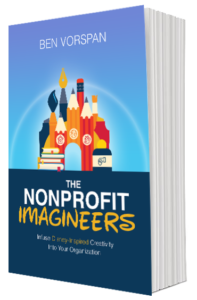
Odds are, after searching through your website or some old brochures, you’ll find that it’s several sentences packed with descriptive multi-syllabic words that make it sound strategic, profound and inspiring. Something like “Our mission is to continue to synergistically empower future-proof paradigms and completely leverage other’s prospective collaboration and idea-sharing such that we may continue to intrinsically impact value-added customer service to delight the customer.” That mission statement, incidentally, is the product of the “mission statement generator” at joe-ks.com, but probably shares at least a few words with your own mission statement. What does it tell you when your mission statement can be confused with one from a joke website?
“Good not-for-profits don’t gunk up their messages with convoluted rationales and multipart platforms.” Nancy Lublin explains in Zilch: The Power of Zero in Business. “They focus on a core idea and pound it home. With the best not-for-profits, you can summarize what they do and what they stand for in a few words. That’s the test of a great but simple brand.”
Aside from sounding formulaic and cliche, the more descriptors, the more “gunked up” and specific your mission statement becomes. All of that leads you down a path that no creative professional can thrive in. As Lublin explains, the “core idea” is most important.
Nordstrom’s mission statement, “provide a fabulous customer experience by empowering customers and the employees who serve them,” says nothing about selling clothing. There’s no mention of cars in Tesla’s mission statement – “To accelerate the world’s transition to sustainable energy.” TED doesn’t say anything about publishing short videos on specific subjects in their 2-word mission statement – “Spread Ideas.” And although Nike alludes to the connection between its products and the human body, it doesn’t mention shoes, and cleverly smashes the traditional definition of the term “athlete” in their mission statement – “Bring inspiration and innovation to every athlete in the world.* *If you have a body, you are an athlete.” By being vague, Tesla opens itself up to manufacturing batteries, solar panels, and all sorts of sustainable energy products. Similarly, TED can “spread ideas” through a variety of mediums and Nike can help “athletes” perform their best by whatever means they choose.
Even Amazon – the 2nd largest company in the world, has just 18 words in their mission statement, “We strive to offer our customers the lowest possible prices, the best available selection, and the utmost convenience.” Whether you’re a customer of merchandise, streaming videos, web hosting, books about non-profit innovation, or the hundreds of other services Amazon offers right now and will branch off in the future, most will agree they’re delivered to you at a low price, in a convenient way, and with a great selection to choose from. In fact, their mission statement has evolved over time, originally aiming “to be Earth’s most customer-centric company, where customers can find and discover anything they might want to buy online, and endeavors to offer its customers the lowest possible prices.” Even in 1995, when their main focus was book sales, they understood the importance of not limiting themselves in their mission statement.
During good times, when an organization is thriving, having such language is helpful to keep an organization moving in the right direction, toward a clear goal. However, when times are lean, and creativity is necessary to reinvigorate an organization, or when the world changes and the needs of the community aren’t what they once were, those specifics can end up doing more harm than good.
It never hurts to analyze your mission statement and decide whether it still works for you. If you feel held back by the language, begin a discussion to update it. To clean it up. To shorten it.
Free yourself of the shackles that a poorly crafted or outdated mission statement can create. “Innovation happens when people are free to think, experiment and speculate.” Heed this advice from Matt Ridley in How Innovation Works. The greatest factor that helps or inhibits innovation is freedom. Ridding yourself of that nagging, constraining mission statement will enable you to be free!
Since you’re probably wondering, here is The Walt Disney Company’s mission statement:
The mission of The Walt Disney Company is to entertain, inform and inspire people around the globe through the power of unparalleled storytelling, reflecting the iconic brands, creative minds and innovative technologies that make ours the world’s premier entertainment company.
Entertaining, informing and inspiring are what Disney is all about, and storytelling is their preferred mode of delivery. It’s specific, but not too specific. Notice, they say nothing about illustration, animation, film production or theme parks. Their mission statement doesn’t mention travel, locations or specific technologies. Simply put, if it’s entertaining, it’s Disney.
It’s important to clarify that I’m not saying your mission should be so broad it stops guiding you. A mission like “To save the world” or “To educate” can lead your organization in too many directions. You might end up doing many things on the surface, but accomplishing no real deep-seeded change. Your mission should be specific enough to keep your staff inspired, but broad enough to allow for creativity.
 Celebrate 2 years of Imagineering!
Celebrate 2 years of Imagineering!
Comments are closed